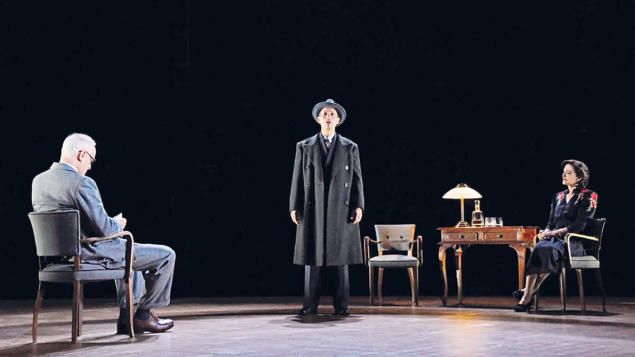Copenhagen, by Michael Frayn, performed at the ADC theatre, Cambridge, UK

“But why?” asks Margrethe Bohr. Her husband, Niels, replies “Does it matter my love now that we’re all three of us dead and gone?” Alongside Werner Heisenberg, the trio look like spirits meeting in an atemporal dimension, maybe the afterlife, under an eerie ring of light. Dominating an almost empty stage, they try to revive what happened on one day in September 1941, when Heisenberg, a prominent figure in Hitler’s Uranverein (Uranium Club), travelled to Nazi-occupied Denmark to visit his former mentor, Niels Bohr.
Why did Heisenberg go to meet Bohr that day? Did he seek an agreement not to develop the bomb in Germany? Was he searching for intelligence on Allied progress? To convince Bohr that there was no German programme? Or to pick Bohr’s brain on atomic physics? Or, according to Margrethe, to show off? Perhaps his motives were a superposition of all of these. No one knows what was said. This puzzle has intrigued historians ever since.
Eighty years after that meeting, and 23 since Michael Frayn’s masterwork Copenhagen premiered at the National Theatre in London, award-winning director Polly Findlay and Emma Howlett in her professional directorial debut have revived a play that contains little action but much physics and food for thought.
The three actors orbit like electrons in an atom
Frayn’s nonlinear script is based on three possible versions of the same meeting in Copenhagen in 1941, which can be construed as three different scenarios playing out in the many-worlds interpretation of quantum mechanics. He describes it as the process of rewriting a draft of a paper again and again, trying to unlock more secrets. In the afterlife, the trio’s dialogue jumps back and forth in time, adding confusing memories and contradicting hypotheses. Delivered at pace, the narrative explores historical information and their personal stories.
The three characters reflect on how German scientists failed to build the bomb, even though they had the best start; Otto Hahn, Lise Meitner and Fritz Strassmann having discovered nuclear fission in 1939. But Frayn highlights how Hitler’s Deutsche Physik was hostile to so-called Jewish physics and key Jewish physicists, including Bohr, who later fled to Los Alamos in the US. Frayn’s Heisenberg reveals the disbelief he felt when he learnt about the destruction of Hiroshima on the radio. At the time he was detained in Farm Hall, not far from this theatre in Cambridge in the UK, together with other members of the Uranium Club. Called Operation Epsilon, the bugged hall was used by the Allied forces to try to uncover the state of Nazi scientific progress.
The three actors orbit like electrons in an atom, while the theatre’s revolving stage itself spins. Superb acting by Philip Arditti and Malcolm Sinclair elucidates an extraordinary student–mentor relationship between Heisenberg and Bohr. The sceptical Mrs Bohr (Haydn Gwynne) steers the conversation and questions their friendship, cajoling Bohr to speak in plain language. Nevertheless, the use of scientific jargon could leave some non-experts in the audience behind.
Although Heisenberg wrote in his autobiography that “it would be better to stop disturbing the spirits of the past,” the private conversation between the two physicists has stirred the interest of the public, journalists and historians for years. In 1956 the journalist Robert Jungk wrote in his debated book, Brighter than a Thousand Suns, that Heisenberg wanted to prevent the development of an atomic bomb. This book was also an inspiration for Frayn’s play. More recently, in 2001, Bohr’s family released some letters that Bohr wrote and never sent to Heisenberg. According to these letters, Bohr was convinced that Heisenberg was building the bomb in Germany.
To this day, the reason for Heisenberg’s visit to Copenhagen remains uncertain, or unknowable, like the properties of a quantum particle that’s not observed. The audience can only imagine what really happened, while considering all philosophical interpretations of the fragility of the human species.







